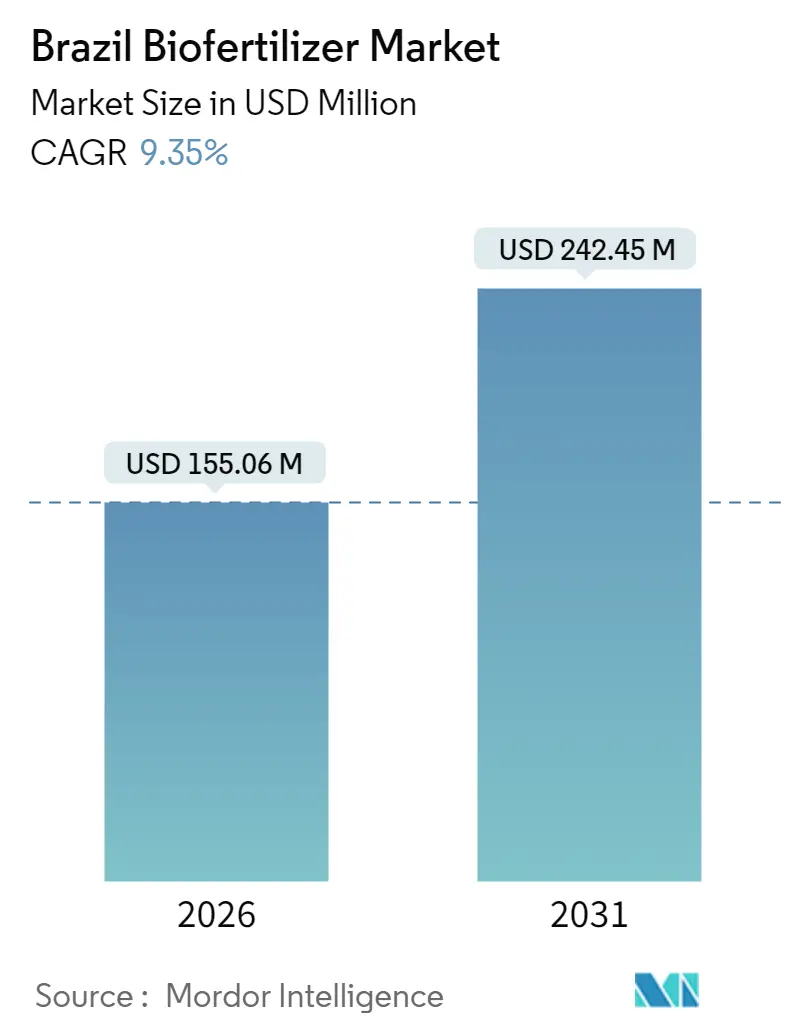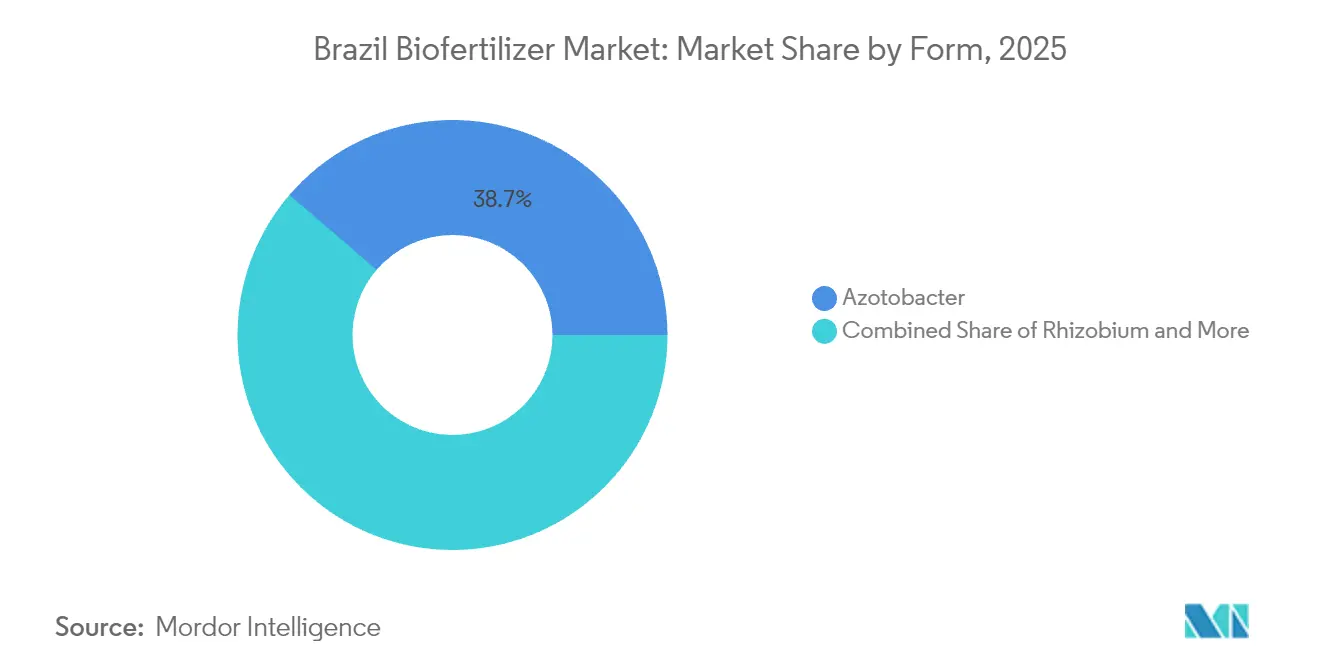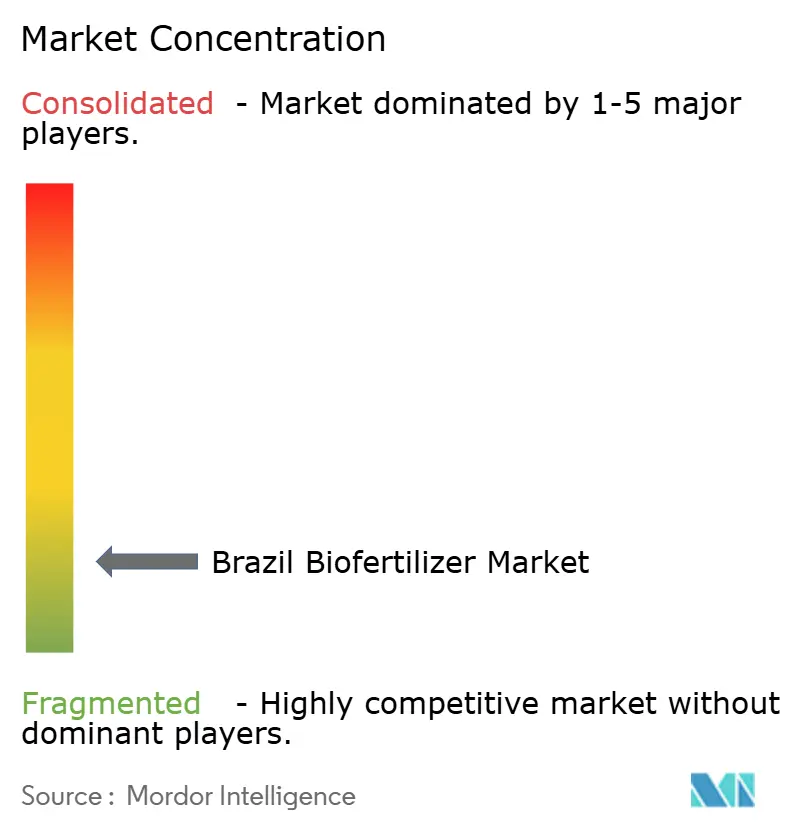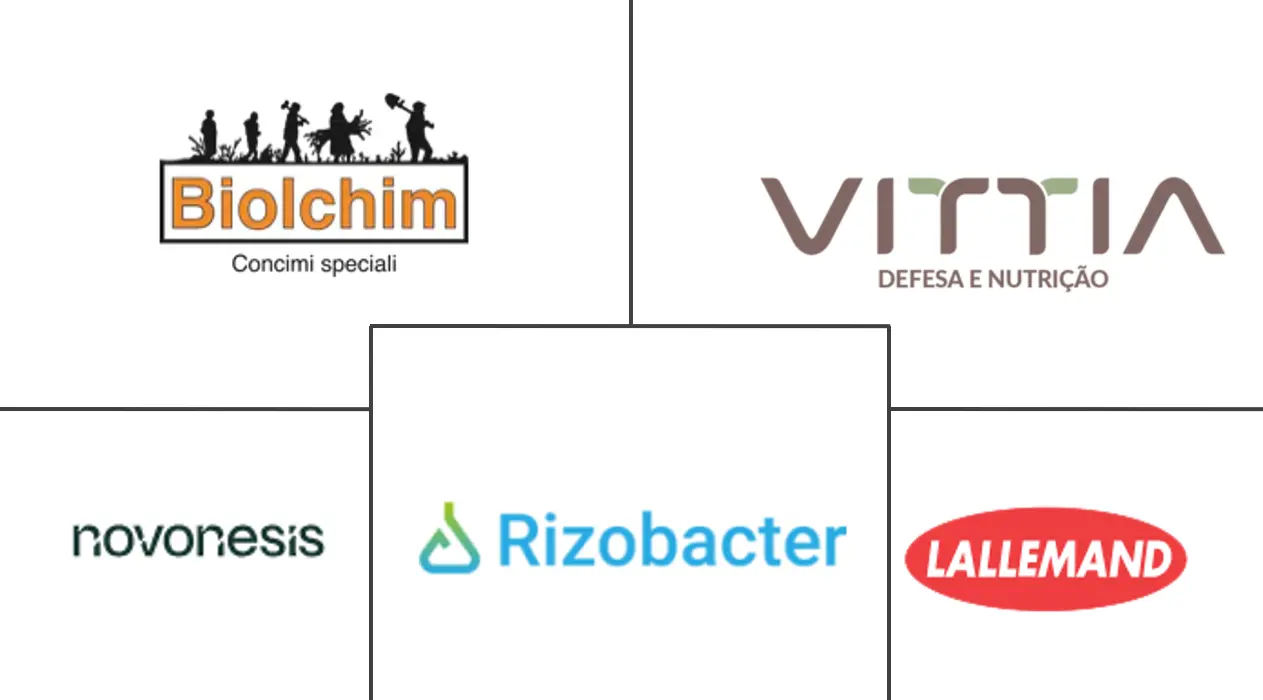Brazil Biofertilizer Market Size and Share

Brazil Biofertilizer Market Analysis by Mordor Intelligence
Brazil biofertilizer market size in 2026 is estimated at USD 155.06 million, growing from 2025 value of USD 141.8 million with 2031 projections showing USD 242.45 million, growing at 9.35% CAGR over 2026-2031. Robust demand from no-till soybean systems, proliferating credit incentives for low-carbon agriculture, and continuous technological advances in multi-strain consortia underpin this growth trajectory [1]Source: Agroberichten Buitenland, “Brazil’s Bio-Input Boom and the Dutch Innovation Mission of November 2024,” agroberichtenbuitenland.nl.Market expansion also benefits from RenovaBio’s carbon‐credit premiums and preferential financing under the Pronaf small-farmer program, both of which reduce the payback period for biological inputs. Meanwhile, innovations in on-farm bioreactors and microbial stacking are lowering per-hectare costs, widening the addressable grower base. Supply-chain constraints, notably seasonal bottlenecks for liquid formulations and limited cold-chain coverage in the North and Northeast, temper near-term upside but do not alter the long-run momentum of the Brazil biofertilizer market.
Key Report Takeaways
- By form, Azotobacter led with 38.70% of Brazil biofertilizer market share in 2025, while Rhizobium is expanding at an 10.88% CAGR through 2031.
- By crop type, row crops accounted for 78.50% of the Brazil biofertilizer market size in 2025 and are advancing at a CAGR of 9.6% to 2031.
- The Brazil biofertilizer market structure is fragmented, with major companies including Vittia Group, Rizobacter, Novozymes (Novonesis Group), Biolchim SpA, and Lallemand Inc. collectively representing nearly 16.10% of market sales in 2025.
Note: Market size and forecast figures in this report are generated using Mordor Intelligence’s proprietary estimation framework, updated with the latest available data and insights as of January 2026.
Brazil Biofertilizer Market Trends and Insights
Drivers Impact Analysis
| Driver | (~) % Impact on CAGR Forecast | Geographic Relevance | Impact Timeline |
|---|---|---|---|
| Accelerated adoption in no-till soybean systems | +2.1% | Center-West and South | Medium term (2-4 years) |
| Expansion of RenovaBio biofuel policy | +1.8% | Nationwide, strongest in sugarcane areas | Long term (≥ 4 years) |
| Government credit lines (Pronaf) favoring biologicals | +1.5% | Nationwide with emphasis on smallholders | Short term (≤ 2 years) |
| Emergence of carbon-credit premiums for biological inputs | +1.3% | Export-oriented Center-West | Medium term (2-4 years) |
| Microbial stacking innovations improving yield stability | +1.1% | Technology-intensive Center-West and South | Long term (≥ 4 years) |
| On-farm bioreactor adoption lowering per-hectare cost | +0.9% | Large farms in Center-West and South | Long term (≥ 4 years) |
| Source: Mordor Intelligence | |||
Accelerated Adoption in No-Till Soybean Systems
No-till now covers more than 32 million ha in Brazil, preserving soil architecture and boosting inoculant survival by up to 60% relative to conventional tillage [2]Source: PMC Authors, “Brief History of Biofertilizers in Brazil,” ncbi.nlm.nih.gov . In soybean areas of the Center-West, biological nitrogen fixation can displace as much as 300 kg of synthetic nitrogen per hectare, translating to savings of USD 180–240 at current fertilizer prices. Producers increasingly move from single-strain Rhizobium to multi-strain blends that add phosphate solubilizers, lifting average yield responses into the 15–25% range. Equipment compatibility further accelerates uptake, as existing seed-treatment lines seamlessly dose liquid inoculants at planting. These economic and logistical advantages cement no-till soybean systems as the anchor customer base for the Brazil biofertilizer market.
Expansion of RenovaBio Biofuel Policy
RenovaBio converts biofertilizer usage into tradeable CBIO credits valued at USD 15–25 per hectare, effectively subsidizing adoption for sugarcane and soon corn and soybean growers. Grain exporters are layering additional price premiums of 2–4% for low-emission crops, tying biological input use to supply-chain verification systems powered by blockchain. São Paulo and Minas Gerais farms are early beneficiaries, but policy expansion scheduled for 2027-2028 will broaden eligibility nationwide. The long-dated horizon positions RenovaBio as a structural demand driver for the Brazil biofertilizer market.
Government Credit Lines (Pronaf) Favoring Biologicals
Pronaf earmarked Brazilian real 1.2 billion (USD 240 million) in 2024 for biological input financing, offering interest rates 2-3 points below standard loans. Smallholders, who manage 23% of Brazil’s farmland, gain immediate liquidity to test inoculants without straining working capital. Embedded technical assistance components focus on best-practice handling, closing historic knowledge gaps. The program’s nationwide footprint and ready capital injection grant it a short-term but powerful uplift on the Brazil biofertilizer market.
Emergence of Carbon-Credit Premiums for Biological Inputs
Commodity traders now pay USD 10–20 per metric ton for soy and corn verified as grown with biological inputs, offsetting 60-80% of inoculant costs for Center-West exporters. Certification is digitally tracked from the farm gate to the port, fostering transparent premium capture. The incentive aligns with global decarbonization commitments and increases the pricing halo around crops produced with biofertilizers, further energizing market adoption.
Restraints Impact Analysis
| Restraint | (~) % Impact on CAGR Forecast | Geographic Relevance | Impact Timeline |
|---|---|---|---|
| Lack of strain-specific registration fast-track | -1.4% | Nationwide | Medium term (2-4 years) |
| Seasonal supply-demand mismatches for liquid inoculants | -1.1% | Nationwide, peaks in planting season | Short term (≤ 2 years) |
| Limited cold-chain logistics in North and Northeast | -0.8% | North and Northeast | Long term (≥ 4 years) |
| Farmer skepticism toward shelf-stable consortia | -0.6% | Smallholder regions, especially Northeast | Medium term (2-4 years) |
| Source: Mordor Intelligence | |||
Lack of Strain-Specific Registration Fast-Track
Brazil’s Ministry of Agriculture still mandates full local field trials even for internationally validated microbes, stretching approval to 3-5 years and delaying innovation cycles. Industry groups continue lobbying for mutual-recognition agreements that could slice timelines by half. Until reforms materialize, the Brazil biofertilizer market endures a drag on novel product introductions.
Seasonal Supply-Demand Mismatches for Liquid Inoculants
Planting windows concentrate roughly 70% of annual inoculant demand into four months. Production capacity cannot stockpile due to six-to-24-month shelf lives, leading to peak-season shortages of 30–40% and price spikes near 20%. Manufacturers are adding storage and extending shelf life, but tight logistics will persist in the near term.
Segment Analysis
By Form: Azotobacter Leads Multi-Strain Evolution
Azotobacter held 38.70% of Brazil biofertilizer market share in 2025, thanks to its dual role in nitrogen fixation and phosphate solubilization. The product category enjoys entrenched brand recognition, particularly in Cerrado soils where acidity intensifies phosphate fixation. Rhizobium, buoyed by rising soybean area, posts an 10.88% CAGR and is often blended with Azotobacter to stabilize field performance. Phosphate-solubilizing bacteria and mycorrhiza segments trail but gain traction in degraded pasture restoration and specialty crop niches. As microbial stacking gains acceptance, formulators increasingly market three-strain packs, lifting average selling prices without eroding farm economics. Shelf-life breakthroughs in encapsulation also extend distribution reach, amplifying the revenue potential of the Brazil biofertilizer market at the formulation level.
Ecosystem collaboration deepens innovation. Advanced formulations now integrate Azotobacter with Rhizobium and phosphate-solubilizing bacteria to create synergistic effects that can increase crop yields by 15-25% compared to single-strain applications . Public-private research programs under Embrapa funnel local strain libraries into commercial pipelines, lowering discovery costs. Coupled with MAPA’s new 2024 bioinputs law, which targets six-to-24-month approvals for low-risk microbes, the regulatory pulse now supports faster market entry. This environment emboldens start-ups to pursue proprietary consortia optimized for Brazil’s climatic zones, adding healthy competitive tension to the incumbent-dominated Brazil biofertilizer industry.

Note: Segment shares of all individual segments available upon report purchase
By Crop Type: Row Crops Dominate Through Scale
Row crops represented 78.50% of Brazil biofertilizer market size in 2025, led by soy and corn across 26 million ha in the Center-West, and is growing at the fastest CAGR of 9.6%. Mechanized planters seamlessly integrate liquid inoculants, keeping per-hectare application costs below USD 7. Cash crops such as sugarcane and cotton contribute 12.30% of value, favored by carbon-credit overlays and year-round nutrient demand. Horticulture, while only 9.20% today, posts double-digit growth as greenhouse and high-value vegetable growers seek residue-free yield enhancers. Greater margin tolerance allows these growers to adopt premium foliar blends and substrate inoculants, pushing biological spend per hectare toward USD 40.
Broader crop diversification strategies also elevate biofertilizer use in crop-livestock rotation systems. Integrating cover crops boosts microbial biomass and reinforces the efficacy of subsequent inoculant applications. This positive feedback loop further entrenches biological inputs in long-term fertility planning, extending the revenue runway of the Brazil biofertilizer market.

Note: Segment shares of all individual segments available upon report purchase
Geography Analysis
The Center-West, anchored by Mato Grosso, generated 44.60% of Brazil biofertilizer market revenue in 2025 as large, tech-savvy growers integrate biological nitrogen fixation across 13 million ha of soybean and corn. Acidic soils respond strongly to phosphate-solubilizing consortia, validating premium pricing models. Regional cooperatives and well-paved transport corridors bolster distribution efficiency, enabling same-week delivery even during peak seasons. The region’s MATOPIBA frontier offers additional acreage that will need microbial inoculation from day one, protecting long-term demand visibility.
The South market is driven by diversified cropping systems that facilitate year-round biofertilizer purchases. Temperate climates extend liquid shelf life, easing cold-chain pressure and cutting spoilage losses below 5%. Strong cooperative networks strengthen farmer education, translating research findings into rapid field adoption. Government extension services focus on integrating biological inputs into sustainable intensification programs, reinforcing the Brazil biofertilizer market’s embeddedness in regional agronomy.
The Southeast, Northeast, and North together represent 26.00% of sales but log the highest CAGR. In São Paulo, sugarcane mills blend vinasse with liquid biofertilizers, creating closed-loop nutrient recycling that lowers synthetic potassium demand. The Northeast’s semi-arid zones gain from drought-tolerant inoculants paired with drip irrigation systems financed under Pronaf. Cold-chain gaps in the North invite shelf-stable granules and local fermentation hubs, shortening lead times by up to 10 days. As logistics and credit frameworks mature, these frontier territories will add incremental volume to the Brazil biofertilizer market size every season.
Competitive Landscape
The Brazil biofertilizer market features prominent players like Vittia Group, Rizobacter, Novozymes A/S (Novonesis Group), Biolchim SpA, and Lallemand Inc., leading the industry through various strategic initiatives, accounting for nearly 16.1% of 2024 sales, signaling a fragmented arena where scale and strain libraries serve as paramount competitive moats. Companies are increasingly focusing on research and development to create innovative biological fertilizer solutions, particularly in nitrogen fixation and nutrient enhancement technologies.
Strategic partnerships shape the innovation pipeline. The SPARCBio public-private hub, launched in December 2024, unites Dutch technology firms with Brazilian researchers to co-develop biological inputs for citrus and grain crops. Cooperative alliances with drone-sprayer manufacturers aim to enhance foliar-application uniformity, opening fresh revenue channels. Start-ups gain traction in on-farm bioreactor technology, offering white-label fermentation modules to large growers seeking self-sufficiency. Despite room for niche disruption, the capital and compliance burden sustains high entry barriers, preserving the concentrated structure of the Brazil biofertilizer market.
Mergers and equity stakes reinforce scale advantages. Multinational seed companies are scouting tie-ups with inoculant suppliers to bundle biological packages with proprietary genetics, locking growers into vertically integrated solutions. Competitive intensity thus pivots from price toward value-added ecosystems, a shift that supports sustained margin profiles across the Brazil biofertilizer industry.
Brazil Biofertilizer Industry Leaders
Biolchim SpA
Lallemand Inc.
Rizobacter
Vittia Group
Novonesis A/S (Novonesis Group)
- *Disclaimer: Major Players sorted in no particular order

Recent Industry Developments
- June 2025: Koppert Biological Systems announced plans to invest USD 200 million in two new biocontrol manufacturing plants in Brazil by 2030.
- December 2024: The São Paulo State Government inaugurated the Applied Research Center for Innovation and Sustainability in Citrus Farming to develop sustainable technologies for citrus protection and to accelerate bio-input research and commercialization.
- December 2024: Brazil enacted Federal Law No. 15.070/2024, creating a unified regulatory framework for bioinputs including microorganisms, plant extracts, and inoculants. The law streamlines procedures for production, registration, and trade, accelerating innovation and investment in the biofertilizer sector.
Brazil Biofertilizer Market Report Scope
| Azospirillum |
| Azotobacter |
| Mycorrhiza |
| Phosphate Solubilizing Bacteria |
| Rhizobium |
| Other Biofertilizers |
| Cash Crops |
| Horticultural Crops |
| Row Crops |
| Form | Azospirillum |
| Azotobacter | |
| Mycorrhiza | |
| Phosphate Solubilizing Bacteria | |
| Rhizobium | |
| Other Biofertilizers | |
| Crop Type | Cash Crops |
| Horticultural Crops | |
| Row Crops |
Market Definition
- AVERAGE DOSAGE RATE - The average application rate is the average volume of biofertilizers applied per hectare of farmland in the respective region/country.
- CROP TYPE - Crop type includes Row crops (Cereals, Pulses, Oilseeds), Horticultural Crops (Fruits and vegetables) and Cash Crops (Plantation Crops, Fibre Crops and Other Industrial Crops)
- FUNCTION - The crop nutrition function of agricultural biological consists of various products that provide essential plant nutrients and enhance soil quality.
- TYPE - Biofertilizers enhance soil quality by increasing the population of beneficial microorganisms. They help crops absorb nutrients from the environment.
| Keyword | Definition |
|---|---|
| Cash Crops | Cash crops are non-consumable crops sold as a whole or part of the crop to manufacture end-products to make a profit. |
| Integrated Pest Management (IPM) | IPM is an environment-friendly and sustainable approach to control pests in various crops. It involves a combination of methods, including biological controls, cultural practices, and selective use of pesticides. |
| Bacterial biocontrol agents | Bacteria used to control pests and diseases in crops. They work by producing toxins harmful to the target pests or competing with them for nutrients and space in the growing environment. Some examples of commonly used bacterial biocontrol agents include Bacillus thuringiensis (Bt), Pseudomonas fluorescens, and Streptomyces spp. |
| Plant Protection Product (PPP) | A plant protection product is a formulation applied to crops to protect from pests, such as weeds, diseases, or insects. They contain one or more active substances with other co-formulants such as solvents, carriers, inert material, wetting agents or adjuvants formulated to give optimum product efficacy. |
| Pathogen | A pathogen is an organism causing disease to its host, with the severity of the disease symptoms. |
| Parasitoids | Parasitoids are insects that lay their eggs on or within the host insect, with their larvae feeding on the host insect. In agriculture, parasitoids can be used as a form of biological pest control, as they help to control pest damage to crops and decrease the need for chemical pesticides. |
| Entomopathogenic Nematodes (EPN) | Entomopathogenic nematodes are parasitic roundworms that infect and kill pests by releasing bacteria from their gut. Entomopathogenic nematodes are a form of biocontrol agents used in agriculture. |
| Vesicular-arbuscular mycorrhiza (VAM) | VAM fungi are mycorrhizal species of fungus. They live in the roots of different higher-order plants. They develop a symbiotic relationship with the plants in the roots of these plants. |
| Fungal biocontrol agents | Fungal biocontrol agents are the beneficial fungi that control plant pests and diseases. They are an alternative to chemical pesticides. They infect and kill the pests or compete with pathogenic fungi for nutrients and space. |
| Biofertilizers | Biofertilizers contain beneficial microorganisms that enhance soil fertility and promote plant growth. |
| Biopesticides | Biopesticides are natural/bio-based compounds used to manage agricultural pests using specific biological effects. |
| Predators | Predators in agriculture are the organisms that feed on pests and help control pest damage to the crops. Some common predator species used in agriculture include ladybugs, lacewings, and predatory mites. |
| Biocontrol agents | Biocontrol agents are living organisms used to control pests and diseases in agriculture. They are alternatives to chemical pesticides and are known for their lesser impact on the environment and human health. |
| Organic Fertilizers | Organic fertilizer is composed of animal or vegetable matter used alone or in combination with one or more non-synthetically derived elements or compounds used for soil fertility and plant growth. |
| Protein hydrolysates (PHs) | Protein hydrolysate-based biostimulants contain free amino acids, oligopeptides, and polypeptides produced by enzymatic or chemical hydrolysis of proteins, primarily from vegetal or animal sources. |
| Biostimulants/Plant Growth Regulators (PGR) | Biostimulants/Plant Growth Regulators (PGR) are substances derived from natural resources to enhance plant growth and health by stimulating plant processes (metabolism). |
| Soil Amendments | Soil Amendments are substances applied to soil that improve soil health, such as soil fertility and soil structure. |
| Seaweed Extract | Seaweed extracts are rich in micro and macronutrients, proteins, polysaccharides, polyphenols, phytohormones, and osmolytes. These substances boost seed germination and crop establishment, total plant growth and productivity. |
| Compounds related to biocontrol and/or promoting growth (CRBPG) | Compounds related to biocontrol or promoting growth (CRBPG) are the ability of a bacteria to produce compounds for phytopathogen biocontrol and plant growth promotion. |
| Symbiotic Nitrogen-Fixing Bacteria | Symbiotic nitrogen-fixing bacteria such as Rhizobium obtain food and shelter from the host, and in return, they help by providing fixed nitrogen to the plants. |
| Nitrogen Fixation | Nitrogen fixation is a chemical process in soil which converts molecular nitrogen into ammonia or related nitrogenous compounds. |
| ARS (Agricultural Research Service) | ARS is the U.S. Department of Agriculture's chief scientific in-house research agency. It aims to find solutions to agricultural problems faced by the farmers in the country. |
| Phytosanitary Regulations | Phytosanitary regulations imposed by the respective government bodies check or prohibit the importation and marketing of certain insects, plant species, or products of these plants to prevent the introduction or spread of new plant pests or pathogens. |
| Ectomycorrhizae (ECM) | Ectomycorrhiza (ECM) is a symbiotic interaction of fungi with the feeder roots of higher plants in which both the plant and the fungi benefit through the association for survival. |
Research Methodology
Mordor Intelligence follows a four-step methodology in all our reports.
- Step-1: Identify Key Variables: In order to build a robust forecasting methodology, the variables and factors identified in Step-1 are tested against available historical market numbers. Through an iterative process, the variables required for market forecast are set and the model is built on the basis of these variables.
- Step-2: Build a Market Model: Market-size estimations for the forecast years are in nominal terms. Inflation is not a part of the pricing, and the average selling price (ASP) is kept constant throughout the forecast period.
- Step-3: Validate and Finalize: In this important step, all market numbers, variables and analyst calls are validated through an extensive network of primary research experts from the market studied. The respondents are selected across levels and functions to generate a holistic picture of the market studied.
- Step-4: Research Outputs: Syndicated Reports, Custom Consulting Assignments, Databases & Subscription Platforms.








